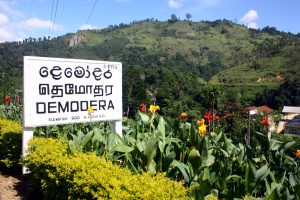The Sri Lankan government’s recent announcement that it would establish a much-delayed post-civil war reconciliation process in the country has been met with skepticism from many Sri Lankans.
Even as this latest attempt at reconciliation is being assessed, some Sri Lankans are finding their own ways to address the brutal historic divisions through what is being described as “linguistic reconciliation.”
Language has played a critical role in Sri Lanka, starting long before the civil war began in 1983. Immediately after independence, a reckless policy to make Sinhala the sole official language was implemented, negatively impacting the status of other minority languages, especially Tamil.
The civil war ended in 2009, with the final stage of the conflict marred by brutal killings of Tamil civilians. But when it comes to truth and reconciliation processes, Sri Lanka has remained stuck.
With the economic and social crisis of 2022, issues of language marginalization have fallen off the radar. Language is often treated as a trivial concern, less important than health or economic development. Yet, at the same time, the state’s powerful encroachment on Tamil language and culture poses a huge threat to peace.
In this climate of intense public distrust of the government’s capacity to progress post-war reconciliation, it is often individuals who step up to address the injustices of the past.
In 1983, Sabitha’s mother was traveling home in a van during the anti-Tamil riots known as Black July. A mob of Sinhala nationalists stopped the van and got on board, shaking bottles of kerosene and ordering the driver to say the Sinhala word for “bucket.” Bucket (baaldhyia in Sinhala) was a shibboleth during these times, an innocuous word that, if pronounced with a Tamil accent, would decide whether its speaker was subject to attack, or worse, death.
Almost 40 years later, after living through a childhood of hiding her mother tongue and her Tamil identity, Sabitha began working as a Tamil language teacher.
In that same year, Manel, a young Sinhala girl, was hiding her best friend’s family in her house to protect them from Sinhala mobs using electoral rolls to target Tamil properties. The Tamil family ended up moving overseas for safety. Manel stopped speaking Tamil altogether and only restarted learning the language nearly 40 years later.
In Sri Lanka, opening a school to teach Tamil as a second language to adults is virtually unheard of. Yet, in 2019, this is precisely what Amita Arudpragasam did when she established Learning Tamil. Growing up, Amita had to work hard to improve her Tamil outside of the education system and could not find suitable adult language courses in Sri Lanka. This inspired her to start the school, which has attracted more than 250 students and teachers like Sabitha and Manel.
Students come from both sides of the so-called ethnic divide. Growing up during the war, students and teachers at the school were denied the right to learn and use Tamil. This had grave consequences for many Sri Lankans including loss of mother tongue and identity, inability to connect with Tamil people, and limited access to Tamil literature, arts, media, and culture.
Tamil people were often unable to access public services in their language as Sinhala chauvinism spread through society and Sinhala language dominated in public forums. Tamil language masses at local churches were cancelled, as was the singing of the national anthem in Tamil. It was common for Tamil families to change the language used at home to English for fear of children being harassed if they spoke Tamil in public.
As one Tamil teacher said, “I have this memory that, as we were walking into school, we were speaking to each other in Tamil, but as we got closer, we had a signal where I would squeeze her hand and we’d switch to English.”
Reconciliation and linguistic justice are at the center of the Sinhala students’ motivations to learn Tamil. As one student said, “I felt that I had to learn the language because we just don’t give it the prominence it deserves.”
Students working on rehabilitation projects in war-affected Tamil regions of the country do not want to rely on interpreters and feel it is important to speak Tamil themselves in order to build trust.
Some students have Tamil partners and want to be able to communicate with their in-laws. “When we have a family, I want to make sure we have Tamil and Sinhala language in it,” one student explained.
Both Tamil and Sinhala members of the school share a vision of linguistic equality and social inclusion for all groups in Sri Lanka. These are signs that public support for progressing reconciliation already exists. Regardless of what process the state introduces, transitional justice is already happening on the ground.
Language is a fundamental human right. February 22 is Global Language Advocacy Day. For more information, visit the Global Coalition for Language Rights.

































